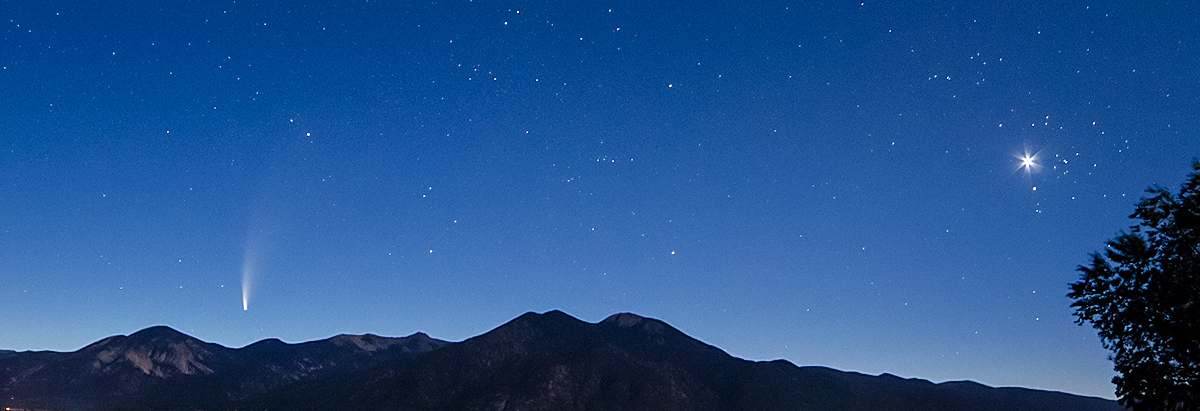
Welcome to taosastronomer.com!
offering
local "hands-on" observing
(visual and imaging) sessions and instruction
viewing and imaging from Rabbit Valley Observatory
a dark sky location on the mesa just west of Taos, NM
Pleiades Star cluster and associated nebulosity/M45 Taurus Constellation |
Image obtained December 02-03, 2021 through RVO's Explore Scientific’s 127mm ES127ED APO refractor resulting in an 952mm f/7.5 optical system and incorporating a HOTECH field flattener -- and employing RVO's new ZWOASI2400MC Pro Sony CMOS-chipped premium one shot color astronomical camera -- 18 of 20 carefully selected and stacked 240-second color light frames combined with multiple dark, flat and bias calibration frames shot at a Gain setting of 160 and using Astro Photography Tool image-acquisition software -- totaling 72 minutes effective luminance; this data used to create the above image. The optics were driven by the Hypertuned Losmandy G-11 mount equipped with Ovision's precision RA worm gear, guided with a ZWO ASI 120MM Monochrome CCD camera through a 60mm guidescope using PhD2 guiding software and post-processed with ASIStudio, DeepSkyStacker, CCDStack2, and Photoshop CS6 s/w. Photographer's note: It is instructive to compare the image above, taken with the superior Explore Scientific apochromatic 127mm refractor (3 optical elements, virtually no false color fringing) and shot with the new ZWOASI full-framed camera with my older previous effort of this well-known object, linked here. The previous image of this very object although beautiful and quite colorful, was captured with a high quality but nevertheless a 2 optical element Williams' Optics Megrez achromatic refractor, and with a uncooled Canon 450XSi, modified for deep-sky use. The difference in the detail (especially noting the stars' lack of significant fringing coloration (halos around stars) and general resolution is extraordinary, due in part to the larger objective lens -- 127mm vs. 80mm -- but also due to the optical type (apochromatic vs. achromatic). Click this link for a discussion of telescopic lens optics. Also, in the case of the original shot, the computer post-processing steps necessary to end up with an acceptable shot was very extensive. The Pleiades image as above required no such rigor in post-processing -- the photographs straight out of the camera were really quite good, requiring really only calibration and stacking; followed by only some minor Photoshop adjustments and mild sharpening. Frankly, after calibration, there was virtually no sharpening or noise reduction needed in post-processing. The new image also displays much less "noise" -- that is because the camera is cooled to far below ambient, rendering it more sensitive and noise-free. One additional note -- the rendered original image is so detailed, that it "begs one to go deep", so to speak. Doing that, I "discovered an intruder photobombing galaxy," as pictured below in a blow-up of my image above; the detail somewhat to the right of the far right bright star (look very closely, detail below). It turns out that this is NOT an illusion. It's galaxy UGC2838, of course far, far beyond the Pleiades (at a distance of ~300 million light years), whereas this pictured local cluster and nebulosity exist in OUR galaxy, at a distance of a mere 444 light years. So the galaxy's light left it BEFORE the dinosaurs, when the Earth had only one continent (Pangea) and amphibian-like animals were just emerging from the sea. Comparatively, the light from the Pleiades left that local Milky Way cluster in Earth year 1577, when, before he was a "Sir," Francis Drake set sail from England on a circumnavigation of the world. It just gives us a little perspective on the size of our known universe. As it turns out, there are literally dozens if not hundreds of distant galaxy groups in the photograph. I noticed quite a few "blurry" spots when I was reviewing the photograph at 200%. Here's a link to that discussion.
Below is a new astrophotography compilation log feature, recently developed here on this website, and inspired by the book The Astrophotography Manual, by Chris Woodhouse -- highly recommended and linked here.
[copyright Rabbit Valley Observatory/Willis Greiner, 2021 -- all rights reserved]
|
(all content copyright 2015-2021 Willis Greiner Photography, all rights reserved)